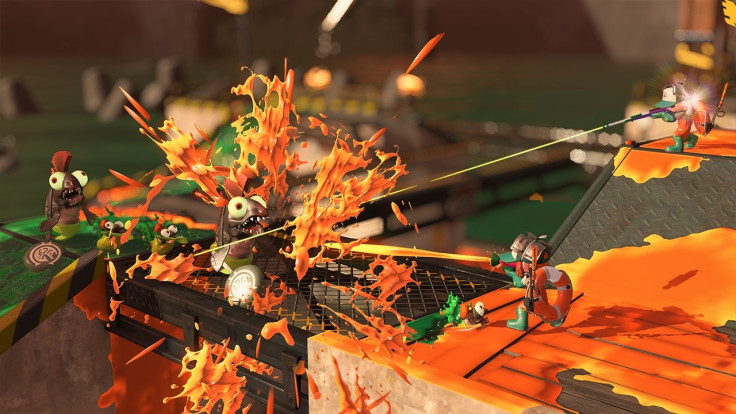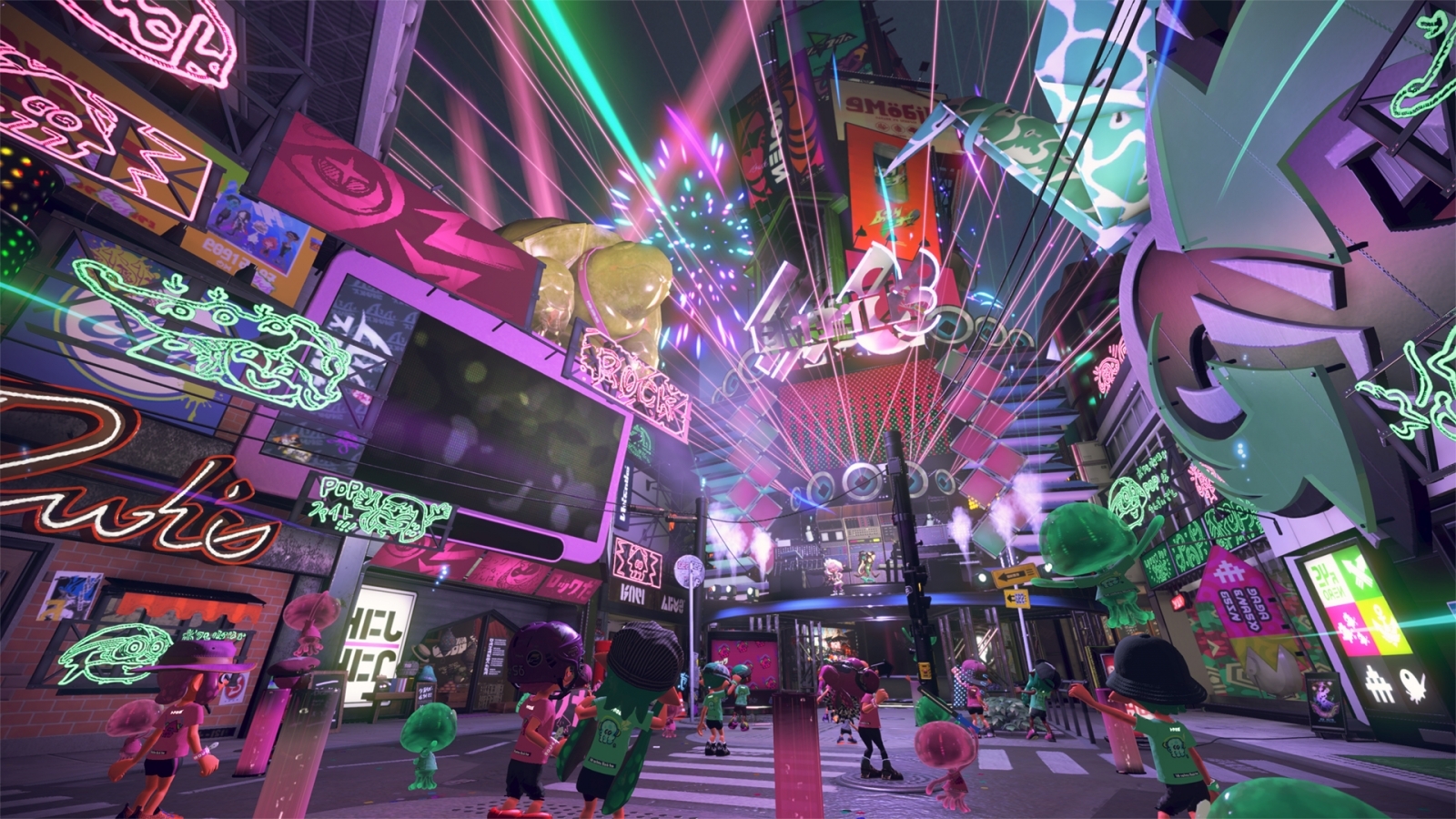Splatoon 2 review: Nintendo's inventive shooter arrives on Switch hoping to stay fresh
Wii U's inventive family-friendly shooter comes to Nintendo Switch.
Splatoon 2
Platforms: Nintendo Switch
Developer: Nintendo
Publisher: Nintendo
Release Date: 21 July
In Splatoon, young characters with the ability to shapeshift into squids spray multiplayer arenas with coloured ink from an arsenal of over-the-top weaponry. Teams of them do so to claim territory, the goal being to have coated more of the map when the timer runs out.
While in squid form, 'Inklings' are able to move quickly through their own ink, but are impeded when they come into contact with their opponents'. Weapons range from conventional guns to giant paint rollers to buckets and exploding curling stones.
If you've never played Nintendo's whip-smart shooter before, that might sound like complete gibberish. That's fine, it sorta is. In practice though, it all makes perfect sense.
Splatoon was Nintendo's first major new IP in years when it launched in 2015, and it was an instant hit. It delighted the Wii U's small userbase with its inversion of shooter tropes - focusing players on shooting the environment rather than other players.
A sequel was inevitable, and on the company's new Switch console there's potential to capture a bigger audience than it ever could have on Wii U - the kind of audience the original deserved. Releasing so early in the hardware's life cycle, Splatoon 2 could also become a fixture of Switch's future success.
Most of us expected Nintendo to announce a straight-forward, Mario Kart 8 Deluxe-style port of the original at its huge Switch press conference in January, but instead they unveiled a full and proper sequel. This instantly changed expectations, so there will certainly be people a little disappointed that Splatoon 2 initially feels so familiar.
Little has changed in terms of its base gameplay, and its four modes of play are all from the original. The single-player campaign too is structured in much the same way as before. There are changes, but most of them are small. New weapons, such as Splat Dualies (which fire like dual sub-machine guns) and Splat Brella (an umbrella that can be fired in a straight line across maps) join revamped versions of weapons from the original game with new special abilities.
These powerful abilities are varied. Players can fire a succession of those exploding curling stones off in any direction, there's the ability to create an ink-showering cloud over the map, a homing bomb, a devastating jet that fires through the environment and another that puts players into an inflatable orb that can roll around the map.

Each of the game's eight arenas is new, but some are versions of maps from the original with tweaked layouts. Splatoon 2 is clearly a case of evolution, not revolution, with most changes existing in the minutiae.
The most noticeable new feature is Salmon Run: a cooperative horde mode. In it, players either going alone or running in groups of up to four are faced with three waves of 'Salmonid' enemies, the difficulty of which is set on a scale from 5% to 200%. Most of these fish-like foes are fairly simple to dispatch, but can swarm the player. More powerful Boss Salmonids require a more tactical approach however, and drop the Golden Eggs needed to complete each round.
Players are set a time limit in which to collect a certain number of the glowing eggs, but the game doesn't stop once they have. Teams need to survive each round, creating a risk-versus-reward element as teams try to add to their egg haul.
It's a frantic and fun new mode that presents a surprisingly hefty challenge. However, the higher the difficulty the greater the need for communication between players, a fact that only serves to expose the clumsiness of Nintendo's solution for team-chat.


Visually, Splatoon 2 represents a significant improvement. When docked the game runs between 850p and 1080p (according to Digital Foundry) and 720p in handheld mode. It looks gorgeous on each, thanks to the Switch's quality screen, a smooth 60fps frame rate and Nintendo's exemplary visual design.
Splatoon 2 has a vibrancy owed to more than just its colour palette. Arena designs and player animations give the game an energetic look, and the mess of ink bathing each map has never looked so satisfyingly gooey. Characters designs are mostly on point, but there are some notably lacklustre customers that don't fit at all. Shop-owners Flow and Bisk are gruesome stand-outs compared to the accomplished designs of the Inklings and characters Callie and Marina.
There might not be a cohesiveness to the design of Splatoon 2's characters, but there is when it comes to gameplay. When you play Splatoon it just makes sense. The many mechanics involved make it difficult to explain in written detail, but in play it's effortlessly simple. It's this simplicity that makes Splatoon so appealing, like Rocket League and Overwatch. Like the best competitive games it is easy to understand but tricky to master.
There's depth too, granted by a trove of clothing items to purchase and improve through play. Leveling up each item you wear will unlock a new passive ability that might speed-up respawn times, increase swim speed or conserve ink. Top tier items have three of these abilities to unlock, so striking the right balance of perks will be a worthwhile pursuit for dedicated players.
Splatoon 2's competitive multiplayer and single-player modes are initially very familiar, but it doesn't take long for Splatoon's core concept to sink its hooks into you, and the sequel's new ideas to come to the fore. As we said in our hands-on preview of the single-player game Splatoon still feels fresh and interesting even after two years. On the surface this sequel may appear to be more of the same, maybe even Splatoon 1.5, but with time it reveals itself to be a game richer in confidence and ideas.
When the original Splatoon was released it was fairly bare. There was no ranked mode, only one game type and five maps. It took months of free updates - the work of a dedicated team of developers - to make it the confident and accomplished game we now know it as. Splatoon 2 is creator Shintaro Sato's concept realised to its potential. It's quite literally everything the first game was and more, which might not mean more revolutionary features but does mean a greater depth and variety of options for the new players it is sure to ensnare. With free updates promised for the best part of a year, the game will only improve, and this time it'll have the audience it deserves.
© Copyright IBTimes 2025. All rights reserved.






















